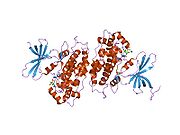FRAT1
Protein-coding gene in the species Homo sapiens
| FRAT1 | |||||||||||||||||||||||||||||||||||||||||||||||||||
|---|---|---|---|---|---|---|---|---|---|---|---|---|---|---|---|---|---|---|---|---|---|---|---|---|---|---|---|---|---|---|---|---|---|---|---|---|---|---|---|---|---|---|---|---|---|---|---|---|---|---|---|
 | |||||||||||||||||||||||||||||||||||||||||||||||||||
| |||||||||||||||||||||||||||||||||||||||||||||||||||
| Identifiers | |||||||||||||||||||||||||||||||||||||||||||||||||||
| Aliases | FRAT1, WNT signaling pathway regulator, FRAT regulator of WNT signaling pathway 1 | ||||||||||||||||||||||||||||||||||||||||||||||||||
| External IDs | OMIM: 602503; MGI: 109450; HomoloGene: 3999; GeneCards: FRAT1; OMA:FRAT1 - orthologs | ||||||||||||||||||||||||||||||||||||||||||||||||||
| |||||||||||||||||||||||||||||||||||||||||||||||||||
| |||||||||||||||||||||||||||||||||||||||||||||||||||
| |||||||||||||||||||||||||||||||||||||||||||||||||||
| |||||||||||||||||||||||||||||||||||||||||||||||||||
| |||||||||||||||||||||||||||||||||||||||||||||||||||
| Wikidata | |||||||||||||||||||||||||||||||||||||||||||||||||||
| |||||||||||||||||||||||||||||||||||||||||||||||||||
Proto-oncogene FRAT1 is a protein that in humans is encoded by the FRAT1 gene.[5][6]
The protein encoded by this gene belongs to the GSK-3-binding protein family. It may function in tumor progression and in lymphomagenesis.[6]
References
- ^ a b c GRCh38: Ensembl release 89: ENSG00000165879 – Ensembl, May 2017
- ^ a b c GRCm38: Ensembl release 89: ENSMUSG00000067199 – Ensembl, May 2017
- ^ "Human PubMed Reference:". National Center for Biotechnology Information, U.S. National Library of Medicine.
- ^ "Mouse PubMed Reference:". National Center for Biotechnology Information, U.S. National Library of Medicine.
- ^ Jonkers J, Korswagen HC, Acton D, Breuer M, Berns A (Mar 1997). "Activation of a novel proto-oncogene, Frat1, contributes to progression of mouse T-cell lymphomas". EMBO J. 16 (3): 441–50. doi:10.1093/emboj/16.3.441. PMC 1169648. PMID 9034327.
- ^ a b "Entrez Gene: FRAT1 frequently rearranged in advanced T-cell lymphomas".
Further reading
- Li L, Yuan H, Weaver CD, et al. (1999). "Axin and Frat1 interact with dvl and GSK, bridging Dvl to GSK in Wnt-mediated regulation of LEF-1". EMBO J. 18 (15): 4233–40. doi:10.1093/emboj/18.15.4233. PMC 1171499. PMID 10428961.
- Saitoh T, Katoh M (2001). "FRAT1 and FRAT2, clustered in human chromosome 10q24.1 region, are up-regulated in gastric cancer". Int. J. Oncol. 19 (2): 311–5. doi:10.3892/ijo.19.2.311. PMID 11445844.
- Bax B, Carter PS, Lewis C, et al. (2002). "The structure of phosphorylated GSK-3beta complexed with a peptide, FRATtide, that inhibits beta-catenin phosphorylation". Structure. 9 (12): 1143–52. doi:10.1016/S0969-2126(01)00679-7. PMID 11738041.
- Saitoh T, Mine T, Katoh M (2002). "Molecular cloning and expression of proto-oncogene FRAT1 in human cancer". Int. J. Oncol. 20 (4): 785–9. doi:10.3892/ijo.20.4.785. PMID 11894125.
- Freemantle SJ, Portland HB, Ewings K, et al. (2002). "Characterization and tissue-specific expression of human GSK-3-binding proteins FRAT1 and FRAT2". Gene. 291 (1–2): 17–27. doi:10.1016/S0378-1119(02)00594-2. PMID 12095675.
- Strausberg RL, Feingold EA, Grouse LH, et al. (2003). "Generation and initial analysis of more than 15,000 full-length human and mouse cDNA sequences". Proc. Natl. Acad. Sci. U.S.A. 99 (26): 16899–903. Bibcode:2002PNAS...9916899M. doi:10.1073/pnas.242603899. PMC 139241. PMID 12477932.
- Hino S, Michiue T, Asashima M, Kikuchi A (2003). "Casein kinase I epsilon enhances the binding of Dvl-1 to Frat-1 and is essential for Wnt-3a-induced accumulation of beta-catenin". J. Biol. Chem. 278 (16): 14066–73. doi:10.1074/jbc.M213265200. PMID 12556519.
- Khambata-Ford S, Liu Y, Gleason C, et al. (2003). "Identification of promoter regions in the human genome by using a retroviral plasmid library-based functional reporter gene assay". Genome Res. 13 (7): 1765–74. doi:10.1101/gr.529803. PMC 403750. PMID 12805274.
- Deloukas P, Earthrowl ME, Grafham DV, et al. (2004). "The DNA sequence and comparative analysis of human chromosome 10". Nature. 429 (6990): 375–81. Bibcode:2004Natur.429..375D. doi:10.1038/nature02462. PMID 15164054.
- Gerhard DS, Wagner L, Feingold EA, et al. (2004). "The status, quality, and expansion of the NIH full-length cDNA project: the Mammalian Gene Collection (MGC)". Genome Res. 14 (10B): 2121–7. doi:10.1101/gr.2596504. PMC 528928. PMID 15489334.
- Wang Y, Hewitt SM, Liu S, et al. (2006). "Tissue microarray analysis of human FRAT1 expression and its correlation with the subcellular localisation of beta-catenin in ovarian tumours". Br. J. Cancer. 94 (5): 686–91. doi:10.1038/sj.bjc.6602988. PMC 2361213. PMID 16479254.
- Hagen T, Cross DA, Culbert AA, et al. (2007). "FRAT1, a substrate-specific regulator of glycogen synthase kinase-3 activity, is a cellular substrate of protein kinase A." J. Biol. Chem. 281 (46): 35021–9. doi:10.1074/jbc.M607003200. PMID 16982607.
External links
- FRAT1 human gene location in the UCSC Genome Browser.
- FRAT1 human gene details in the UCSC Genome Browser.
- v
- t
- e
PDB gallery
-
 1gng: GLYCOGEN SYNTHASE KINASE-3 BETA (GSK3) COMPLEX WITH FRATTIDE PEPTIDE
1gng: GLYCOGEN SYNTHASE KINASE-3 BETA (GSK3) COMPLEX WITH FRATTIDE PEPTIDE
 | This article on a gene on human chromosome 10 is a stub. You can help Wikipedia by expanding it. |
- v
- t
- e



















